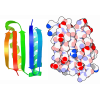[English] 日本語
 Yorodumi
Yorodumi- PDB-3bx7: Engineered Human Lipocalin 2 (LCN2) in Complex with the Extracell... -
+ Open data
Open data
- Basic information
Basic information
| Entry | Database: PDB / ID: 3bx7 | ||||||
|---|---|---|---|---|---|---|---|
| Title | Engineered Human Lipocalin 2 (LCN2) in Complex with the Extracellular Domain of Human CTLA-4 | ||||||
 Components Components |
| ||||||
 Keywords Keywords | DE NOVO PROTEIN / PROTEIN BINDING / PROTEIN DESIGN / PROTEIN-PROTEIN COMPLEX / GLYCOPROTEIN / IMMUNOGLOBULIN DOMAIN / POLYMORPHISM / TRANSMEMBRANE PROTEIN | ||||||
| Function / homology |  Function and homology information Function and homology informationprotein complex involved in cell adhesion / negative regulation of regulatory T cell differentiation / RUNX1 and FOXP3 control the development of regulatory T lymphocytes (Tregs) / clathrin-coated endocytic vesicle / Co-stimulation by CD28 / Co-inhibition by CTLA4 / negative regulation of B cell proliferation / negative regulation of T cell proliferation / B cell receptor signaling pathway / T cell receptor signaling pathway ...protein complex involved in cell adhesion / negative regulation of regulatory T cell differentiation / RUNX1 and FOXP3 control the development of regulatory T lymphocytes (Tregs) / clathrin-coated endocytic vesicle / Co-stimulation by CD28 / Co-inhibition by CTLA4 / negative regulation of B cell proliferation / negative regulation of T cell proliferation / B cell receptor signaling pathway / T cell receptor signaling pathway / adaptive immune response / immune response / positive regulation of apoptotic process / external side of plasma membrane / DNA damage response / perinuclear region of cytoplasm / Golgi apparatus / plasma membrane Similarity search - Function | ||||||
| Biological species |  Homo sapiens (human) Homo sapiens (human) | ||||||
| Method |  X-RAY DIFFRACTION / X-RAY DIFFRACTION /  SYNCHROTRON / SYNCHROTRON /  MOLECULAR REPLACEMENT / Resolution: 2.1 Å MOLECULAR REPLACEMENT / Resolution: 2.1 Å | ||||||
 Authors Authors | Schonfeld, D.L. / Chatwell, L. / Skerra, A. | ||||||
 Citation Citation |  Journal: To be Published Journal: To be PublishedTitle: High affinity molecular recognition and functional blockade of CTLA-4 by an engineered human lipocalin Authors: Schonfeld, D.L. / Matschiner, G. / Chatwell, L. / Trentmann, S. / Schlehuber, S. / Hohlbaum, A. / Skerra, A. | ||||||
| History |
|
- Structure visualization
Structure visualization
| Structure viewer | Molecule:  Molmil Molmil Jmol/JSmol Jmol/JSmol |
|---|
- Downloads & links
Downloads & links
- Download
Download
| PDBx/mmCIF format |  3bx7.cif.gz 3bx7.cif.gz | 73.8 KB | Display |  PDBx/mmCIF format PDBx/mmCIF format |
|---|---|---|---|---|
| PDB format |  pdb3bx7.ent.gz pdb3bx7.ent.gz | 54.3 KB | Display |  PDB format PDB format |
| PDBx/mmJSON format |  3bx7.json.gz 3bx7.json.gz | Tree view |  PDBx/mmJSON format PDBx/mmJSON format | |
| Others |  Other downloads Other downloads |
-Validation report
| Summary document |  3bx7_validation.pdf.gz 3bx7_validation.pdf.gz | 440.1 KB | Display |  wwPDB validaton report wwPDB validaton report |
|---|---|---|---|---|
| Full document |  3bx7_full_validation.pdf.gz 3bx7_full_validation.pdf.gz | 442.6 KB | Display | |
| Data in XML |  3bx7_validation.xml.gz 3bx7_validation.xml.gz | 14.8 KB | Display | |
| Data in CIF |  3bx7_validation.cif.gz 3bx7_validation.cif.gz | 20.8 KB | Display | |
| Arichive directory |  https://data.pdbj.org/pub/pdb/validation_reports/bx/3bx7 https://data.pdbj.org/pub/pdb/validation_reports/bx/3bx7 ftp://data.pdbj.org/pub/pdb/validation_reports/bx/3bx7 ftp://data.pdbj.org/pub/pdb/validation_reports/bx/3bx7 | HTTPS FTP |
-Related structure data
| Related structure data | 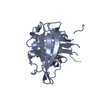 3bx8C  1dfvS  1i85S C: citing same article ( S: Starting model for refinement |
|---|---|
| Similar structure data |
- Links
Links
- Assembly
Assembly
| Deposited unit | 
| ||||||||
|---|---|---|---|---|---|---|---|---|---|
| 1 | 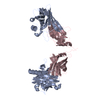
| ||||||||
| Unit cell |
|
- Components
Components
| #1: Protein | Mass: 13310.083 Da / Num. of mol.: 1 Source method: isolated from a genetically manipulated source Source: (gene. exp.)  Homo sapiens (human) / Gene: CTLA4, CD152 / Plasmid: pCTLA4-8 / Production host: Homo sapiens (human) / Gene: CTLA4, CD152 / Plasmid: pCTLA4-8 / Production host:  |
|---|---|
| #2: Protein | Mass: 20192.723 Da / Num. of mol.: 1 Source method: isolated from a genetically manipulated source Source: (gene. exp.)  Homo sapiens (human) / Plasmid: pNGAL62 / Production host: Homo sapiens (human) / Plasmid: pNGAL62 / Production host:  |
| #3: Water | ChemComp-HOH / |
| Has protein modification | Y |
-Experimental details
-Experiment
| Experiment | Method:  X-RAY DIFFRACTION / Number of used crystals: 1 X-RAY DIFFRACTION / Number of used crystals: 1 |
|---|
- Sample preparation
Sample preparation
| Crystal grow | Temperature: 293.15 K / Method: vapor diffusion, sitting drop / pH: 8.4 Details: 1.4 M Na-malonate, pH 8.4, VAPOR DIFFUSION, SITTING DROP, temperature 293.15K |
|---|
-Data collection
| Diffraction | Mean temperature: 100 K |
|---|---|
| Diffraction source | Source:  SYNCHROTRON / Site: SYNCHROTRON / Site:  BESSY BESSY  / Beamline: 14.1 / Wavelength: 0.95373 Å / Beamline: 14.1 / Wavelength: 0.95373 Å |
| Detector | Type: MARMOSAIC 225 mm CCD / Detector: CCD / Date: Oct 31, 2006 / Details: mirror |
| Radiation | Monochromator: Si-111 crystal / Protocol: SINGLE WAVELENGTH / Monochromatic (M) / Laue (L): M / Scattering type: x-ray |
| Radiation wavelength | Wavelength: 0.95373 Å / Relative weight: 1 |
| Reflection | Resolution: 2.1→25 Å / Num. obs: 40987 / % possible obs: 98.9 % / Redundancy: 8.6 % / Rsym value: 4.9 / Net I/σ(I): 30 |
| Reflection shell | Resolution: 2.1→2.18 Å / Redundancy: 8.1 % / Mean I/σ(I) obs: 3.3 / Rsym value: 41.9 / % possible all: 96.8 |
- Processing
Processing
| Software |
| ||||||||||||||||||||||||||||
|---|---|---|---|---|---|---|---|---|---|---|---|---|---|---|---|---|---|---|---|---|---|---|---|---|---|---|---|---|---|
| Refinement | Method to determine structure:  MOLECULAR REPLACEMENT MOLECULAR REPLACEMENTStarting model: PDB ENTRY 1I85 chain C, PDB ENTRY 1DFV chain B Resolution: 2.1→20 Å / σ(F): 0 / Stereochemistry target values: Engh & Huber
| ||||||||||||||||||||||||||||
| Solvent computation | Bsol: 48.786 Å2 | ||||||||||||||||||||||||||||
| Displacement parameters | Biso mean: 39.06 Å2
| ||||||||||||||||||||||||||||
| Refinement step | Cycle: LAST / Resolution: 2.1→20 Å
| ||||||||||||||||||||||||||||
| Refine LS restraints |
| ||||||||||||||||||||||||||||
| LS refinement shell | Resolution: 2.1→2.18 Å /
| ||||||||||||||||||||||||||||
| Xplor file |
|
 Movie
Movie Controller
Controller


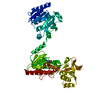
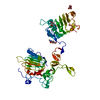
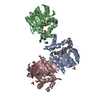
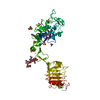

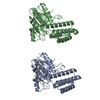
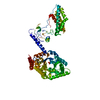
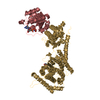
 PDBj
PDBj